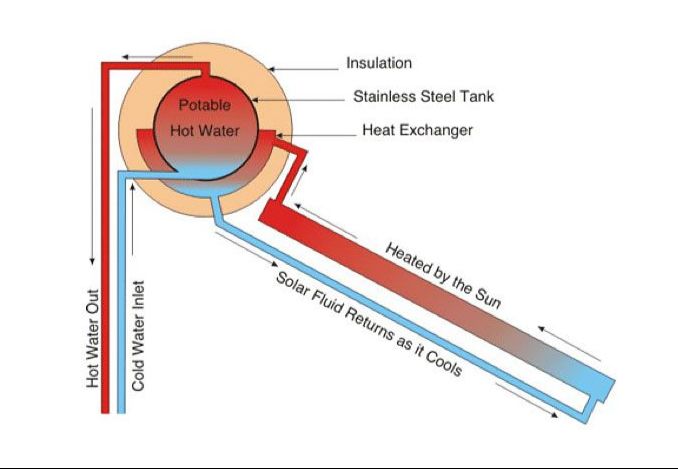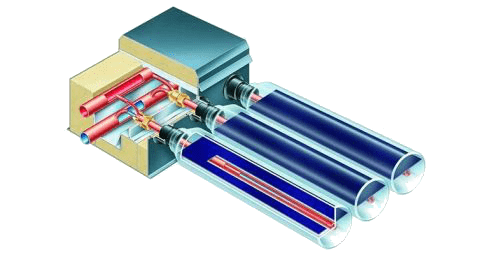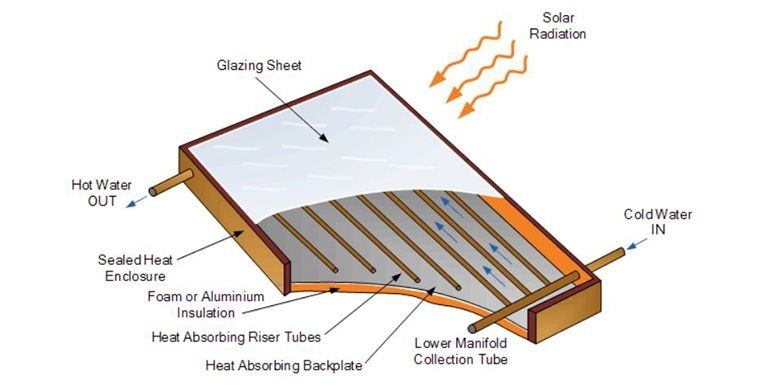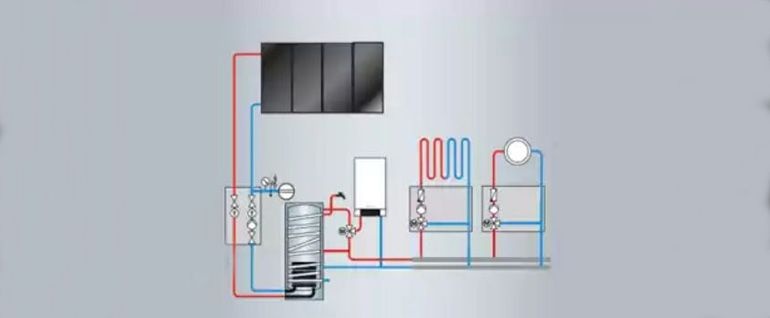Choosing the right solar water heater system
We love modern homes not only for the architecture, even more, not so much for the architecture, but the care of the environment. The environment does not end inside our home, it is wherever we go, so it is important that our home is safe not only when we are inside but also outside. This safety is also achieved by seeking to reduce harmful emissions to the atmosphere to breathe clean air. This is facilitated by the use of clean energy sources, one of which is solar energy. This article will talk about water heating by the sun, used in the bathroom, kitchen, or heating.

What is a solar thermal collector?
We have already talked about photovoltaic (PV) solar collectors that convert solar radiation into electricity. Solar thermal collector, or solar collector (from the word helios —Greek., the sun), is much easier. It is a device that collects heat directly from solar radiation. It can be used as the primary heat source and other traditional sources operating on biofuel or electricity. On the Internet, there are many models of solar panels made by home craftsmen. Still, there are also available factory solar installations that can heat water and space heating.
In a warm climate in a thermal solar collector, it is possible to use water passing through its panels, but in a cold environment, glycol is used to prevent the freezing of meetings.
The efficiency of solar thermal collectors:
The panel's efficiency is partly determined by the absorption rate of solar radiation and partly by its emissivity; in other words, how much heat it can absorb and how much it will emit (or lose) before warm water is delivered to its destination.
Earlier models had absorption coefficients in the range of 90-95% (solar radiation absorption efficiency), but they also had a high loss coefficient — in the field of 55-95%. Most of the accumulated heat was lost, already in the panel.
These models also used standard black paint, while modern panels are made with a specially designed coating to absorb and retain heat.
Even though the modern generation of solar collectors is very efficient, their competitors-solar photovoltaic panels are more efficient than thermal solar panels, so they are considered a more profitable investment. This does not mean that the quality and efficiency of solar thermal collectors are low. It is better to spend money on solar photovoltaic cells and use the generated electricity in a conventional electric water heater. This is due to the ever-evolving technologies and lower costs in the photovoltaic industry. In contrast, the production of solar collectors and the price remained relatively stable over the same period. They are still good, and the problem is that the competition continues to increase.
This philosophy's premise is that the heat collector brings no benefit when hot water is not needed. If the solar installation were photovoltaic rather than thermal, solar radiation would always be absorbed to generate electricity, power other household appliances, store in batteries, or return to the power supply systems that would soon appear in Russia. It's hard to deny this logic; however, there are situations where thermal solar energy is valuable, so we'll describe the options.
Vacuum tube collectors

The tubular vacuum collector is able to convert even a small amount of solar energy into useful heat.
Tubular solar collectors ©Viessmann
This is the most common type of solar heat collector you've probably seen on rooftops. The panel of the vacuum collector most often consists of glass pipes, inside which there are copper tubes, with a darkened plate covering the box to absorb heat. Glass tubes are hermetically sealed, and only part of the copper fittings remains open. Each line is installed in the collector separately.
This makes it easy to replace the pipe if the vacuum seal breaks. They are also easier to mount instead of lifting one heavy panel onto the roof, and they can be disassembled into separate pipes and then assembled into panels.
Hermetically sealed air is an excellent heat insulator, so the panel is almost unaffected by the outside temperature in winter. And in hot summer, you can touch the pipes with your bare hand, although the inner tube could burn.
Flat solar collectors

Flat solar collector collects more heat than tubular collector
Of course, the designs are different, but the usual flat plate collector is more than a shallow box with a copper tube stretched through it, covered with a metal plate absorber and a transparent cover. Cool liquid passes through the copper tubes under the surface of the collector and is heated in the process of passing.
Both flat and tubular collectors use a mixture of glycol and water in the tubes, so a separate tank is needed to heat the water, in which the coil of the heat exchanger passes.
Which is better flat or evacuated tube collectors?
Each type of solar collector has advantages and disadvantages. The air inside the hermetically sealed glass tubes in the vacuum collectors provides much better insulation than flat plate collectors. Still, some of the solar energy is lost when passing through the gaps between the tubes.
More heat is lost in a flat plate collector than in a tubular one, but it can collect more energy since its entire surface absorbs sunlight.
Thus, the summer flat solar collector will produce more energy than a vacuum in the absence of other factors. It has a large surface area, and the ambient temperature is not a problem.
Conversely, the air temperature causes much more significant energy losses in a flat solar collector than in a tubular solar panel in winter. Hence, a tubular vacuum solar panel design is more efficient.
The choice of design that is best suited for your home depends on the intended use. If you want to reduce the cost of heating water in the summer in the country, you will probably benefit from a flat solar collector. Suppose you intend to use it together with the boiler for heating rooms and heating hot water in the winter in the house for permanent residence. In that case, you will benefit more from the vacuum heat collector because it works better in winter compared to flat geo collectors.
Heat transfer

Scheme of heat transfer from the solar heat collector to the house.
In systems with glycol, you need a heat exchanger for hot water, space heating, or both. The heated liquid from the solar collectors heats the water when it passes through the coil in the tank. An additional loop in the tank heated by gas or electricity will heat the water if the solar collector cannot maintain the desired temperature or keep up with hot water consumption.
Maintenance and durability
Depending on the operating conditions, solar collectors can last 20-25 years and require almost no maintenance. A significant disadvantage of using solar collectors in cold climates is using a mixture of water and ethylene glycol in equal parts. In winter, ethylene glycol is necessary to keep the liquid in the tubes from freezing. 50% mixture of ethylene glycol does not freeze to -35°C. In Summer, the temperature of flat-plate collectors can reach 200°C, and tubular solar collectors 295°C. When heated above 150 °C, the thermal decomposition of ethylene glycol begins, contributing to corrosion and scale formation. Therefore, the panels must use some cooling components included in the design, whether manual or automatic. Also, ethylene glycol is a toxic substance.
How reasonable is it to use the sun to heat water directly?
The need to use ethylene glycol as a heat transfer fluid and the problems that arise with it lead to a decrease in the popularity of solar collectors in cold climates. Reducing the cost of photovoltaic solar panels and their flexibility makes solar collectors less competitive as long-term investments.